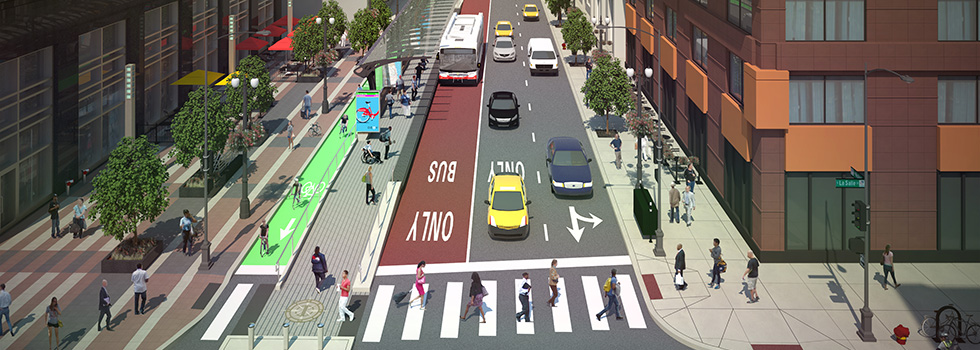Bus Rapid Transit

Chicago’s new route to opportunity
Issue
Long commutes, poor connections for many Chicagoans
Bus Rapid Transit (BRT) provides rail-like speed, convenience and community benefits at a fraction of the cost.
An effective transportation network makes connections—between people and the places they want and need to go, between businesses and customers, and between neighborhoods and the broader city and region. Chicago’s rapid transit network was built with the assumption that most travelers needed to go downtown, leading to our hub-and-spoke system of rail lines that converge on the Loop. Cross-town trips—those that do not need to pass through downtown—require slow bus trips.
Over 10 million people travel by bus each year on the north-south Ashland corridor—more than some Chicago Transit Authority (CTA) rail lines—but they must endure delays and unreliable service. Even many bus trips within the Loop, such as between Union Station and Millennium Park, are delayed by automobile traffic, increasing commute times for workers and reducing productivity.
Solutions
New rapid, reliable transit service
BRT is a new standard of transit service that provides rail-like speed and convenience at a fraction of the cost of installing rail. MPC’s Bus Rapid Transit: Chicago’s New Route to Opportunity lays the groundwork for a 10-route BRT network in Chicago that would provide more equitable transit service to help people access jobs, shops, schools, hospitals and other destinations across the city.
Gold standard BRT includes four key elements that make it truly a rapid transit experience: dedicated bus lanes, pay-before-you-board stations, signal prioritization and at-grade boarding. After piloting some elements of BRT on Jeffery Boulevard; the City of Chicago built Loop Link in 2015.
MPC continues to advocate that the Chicago DOT and CTA advance a network of BRT corridors.
Benefits
Better transportation options, new development opportunities
- BRT will provide new connectivity to neighborhoods that otherwise lack good transportation access.
- Loop Link, BRT in the Central Loop, will improve connectivity within the region’s primary business district, linking people to jobs and multiple modes of public transportation.
- BRT on Ashland Avenue will create essential north-south connections while linking to existing CTA and Metra rail stations.
- BRT’s enhanced service and substantial, neighborhood-defining stations will generate high-potential opportunities for community and economic development along the Ashland corridor.
Collaborators
Active Transportation Alliance
Chicago Architecture Foundation
The Chicago Community Trust
Chicago Dept. of Transportation
Chicago Transit Authority
Civic Consulting Alliance
Institute for Transportation and Development Policy
Urban Land Institute—Chicago
